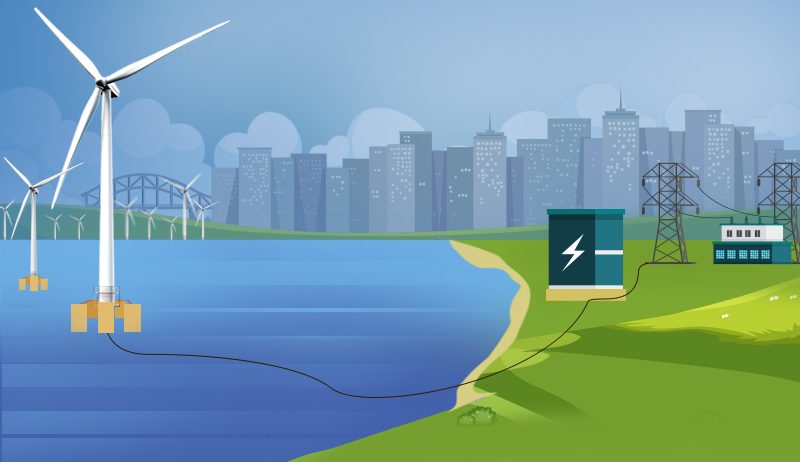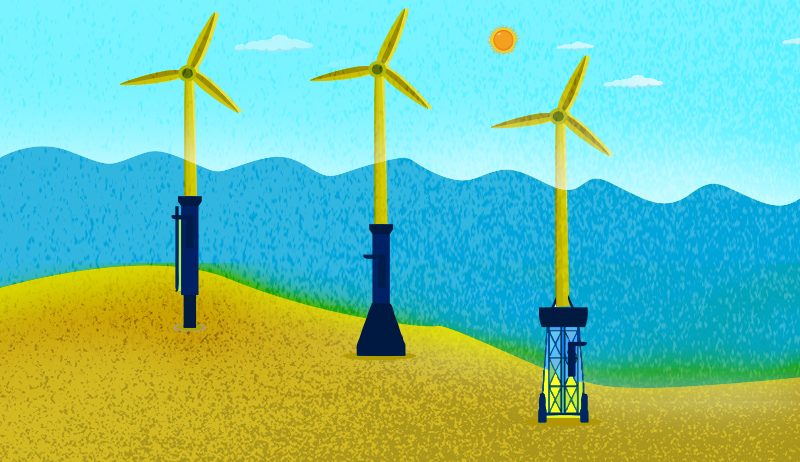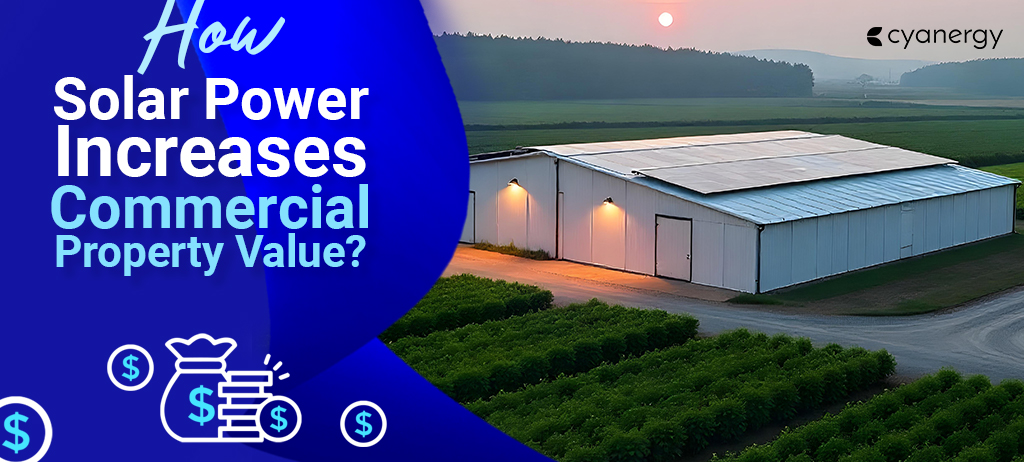Offshore wind farms help to make clean energy and reduce pollution from fossil fuels like coal and gas.
This energy is then sent through cables to shore, where it can be used to power homes, businesses, and other places.
But how is this the future of renewable energy in Australia? Let’s find out more about offshore wind farms in Australia.
Offshore Wind Farms 101, What is an Offshore Wind Farm?
Offshore wind farms require a huge set of wind turbines that are set up in the ocean. It is kind of like underwater fields of windmills. They use the power of the wind to generate electricity.
Offshore wind farms are located in the ocean, usually a fair distance from the coast. In Australia, they might be found off the coasts of states like Victoria, New South Wales, or South Australia.
Wind Turbines are like really tall, slim towers with big propeller-like blades on top. They spin when the wind blows, and this spinning motion generates electricity. Each turbine can produce a lot of power.
Electricity generated by the turbines is sent through cables underwater to the shore. From there, it’s distributed to homes, businesses, and other places that need electricity.
Building an offshore wind farm involves a lot of planning and construction. It requires special ships and equipment to install the turbines securely on the ocean floor.
Offshore wind farms are an essential part of Australia’s renewable energy future. It will help to reduce carbon emissions and move towards a more sustainable energy system.
Offshore Wind Farm Zones
Specific offshore wind farm zones in Australia had not been formally designated. However, several regions around the Australian coastline are considered to have high potential for offshore wind development.
These regions include:
Victoria: The waters off the southern coast of Victoria, particularly in the Bass Strait, are known for their strong and consistent winds, making them prime candidates for offshore wind farms.
New South Wales: The coastline of New South Wales, especially in areas such as Newcastle and Sydney, also experiences strong offshore winds that could support offshore wind projects.
Tasmania: Tasmania, surrounded by the Bass Strait and the Southern Ocean, offers significant potential for offshore wind development. Projects off the coast of Tasmania could harness the region’s abundant wind resources.
South Australia: The waters off the coast of South Australia, including the Great Australian Bight, have been identified as having favorable conditions for offshore wind energy generation.
While specific zones for offshore wind farms have not been officially designated, developers and government authorities are conducting studies and assessments to identify suitable locations and potential lease areas for offshore wind development.
These studies consider factors such as wind resource availability, water depth, seabed conditions, environmental sensitivity, and proximity to existing infrastructure.
Offshore Wind Farms: Future of Renewable Energy in Australia

Australia has lots of wind, especially along its coastlines. Offshore wind farms take advantage of this windy environment to generate electricity.
Plus, it’s a way for Australia to tap into renewable energy sources, which are better for the environment than fossil fuels.
Offshore wind farms are like giant windmills in the ocean. They use the wind to turn big blades on tall towers. When the blades spin, they create electricity.
This electricity is then sent through cables back to the shore and into the power grid, where homes, businesses, and industries can use it.
Australia has vast coastlines, which make it perfect for offshore wind farms. Places like Victoria, New South Wales, and South Australia have strong winds blowing over the ocean, making them ideal locations for these wind farms.
Building an offshore wind farm is a big job. It involves carefully planning where to put the wind turbines, how to install them securely on the seabed, and how to connect them to the power grid. Special ships and equipment are needed for this job.
Offshore wind is the newest frontier for renewable energy in Australia. As technology advances and costs decrease, we expect more offshore wind farms along Australia’s coastlines.
What Offshore Wind Farm Projects are Currently Active in Australia?
Australia was in the early stages of exploring offshore wind energy projects.
However, there have been several notable developments and announcements:
Star of the South:
This is one of the most advanced offshore wind projects in Australia. Located off the coast of Victoria, it aims to be one of the largest offshore wind farms in the world once completed.
The project has received development approval from the Australian government and is moving forward with feasibility studies and environmental assessments.
Offshore Energy:
Tasmanian Projects:
Tasmania, with its abundant wind resources, is also exploring offshore wind energy. Several projects have been recommended off the coast of Tasmania, including the proposed Robbins Island and Jim’s Plain projects.
These projects are in various stages of development, with feasibility studies and environmental assessments ongoing.
Other Potential Projects:
There are discussions and preliminary studies for offshore wind projects in other parts of Australia, including New South Wales and South Australia.
These projects are still in the early stages, with developers assessing the feasibility and potential of offshore wind energy in these regions.
Australia’s offshore wind industry is still in its early stages compared to other countries like the UK and Denmark.
There is growing interest and momentum in exploring the potential of offshore wind energy to contribute to Australia’s renewable energy target and reduce greenhouse gas emissions.
What are the Steps to Create Offshore Wind Farms in Australia

Planning and Assessment:
- Identify suitable locations with strong and consistent winds off the coastlines of Australia.
- Conduct environmental assessments to understand the potential impacts on marine life, habitats, and ecosystems.
- Engage with local communities, stakeholders, and Indigenous groups to gather feedback and address concerns.
Obtaining Approvals:
- Seek approval from relevant government authorities for the development of offshore wind projects.
- Obtain permits for activities such as seabed surveys, environmental impact assessments, and construction.
Feasibility Studies:
- Conduct detailed feasibility studies to assess the technical, economic, and environmental viability of the proposed offshore wind farm.
- Evaluate factors such as wind resource assessment, seabed conditions, grid connection options, and project financing.
Design and Engineering:
- Develop detailed engineering designs for the offshore wind turbines, foundations, and electrical infrastructure.
- Optimize the layout of the wind farm to maximize energy generation while minimizing environmental impacts.
Construction:
- Mobilize vessels, equipment, and personnel to the project site.
- Install foundations for the wind turbines on the seabed.
- Assemble and erect the wind turbine towers and blades.
- Lay submarine cables to connect the turbines to the onshore power grid.
Operation and Maintenance:
- Commission the offshore wind farm and start generating electricity.
- Monitor the performance of the turbines and electrical infrastructure.
- Conduct regular inspections, maintenance, and repairs to ensure the safe and efficient operation of the wind farm.
Monitoring and Compliance:
- Implement environmental monitoring programs to track the impacts of the offshore wind farm on marine ecosystems.
- Comply with regulatory requirements and permit conditions.
- Engage with stakeholders and communities to address any ongoing concerns or issues.
Expansion and Upgrades:
- Consider opportunities for expanding the offshore wind farm or upgrading existing infrastructure to increase capacity and improve efficiency.
- Evaluate technological advancements and innovations to enhance the performance and reliability of the offshore wind farm over time.
Benefits of Offshore Wind Farms in Australia
Clean Energy
Abundant Wind Resources
Australia has vast coastlines with strong and consistent winds, especially in regions like Victoria, New South Wales, and South Australia. Offshore wind farms take advantage of these abundant wind resources to generate electricity efficiently.
Job Creation
Building, operating, and maintaining offshore wind farms create job opportunities in various sectors, including construction, engineering, manufacturing, and maintenance.
This can help to stimulate economic growth and support local communities, particularly in coastal regions where offshore wind projects are located.
Energy Security:
Environmental Benefits:

Offshore wind farms have lower environmental impacts compared to traditional fossil fuel power plants.
They produce no air or water pollution during operation and have minimal land use requirements. Additionally, offshore wind farms can provide habitat for marine life, acting as artificial reefs.
Technological Innovation:
Climate Change Mitigation:
Offshore wind farms play a crucial role in mitigating climate change by reducing greenhouse gas emissions. By transitioning to renewable energy sources like offshore wind, Australia can contribute to global efforts to combat climate change and limit temperature rise.
Offshore wind farms offer significant benefits to Australia, including clean energy generation, job creation, energy security, environmental protection, and climate change mitigation.
Embracing offshore wind energy can help Australia achieve its renewable energy target while fostering economic growth and environmental sustainability.
Contact Cyanergy for any renewable energy or solar solutions. Talk to an expert today!







